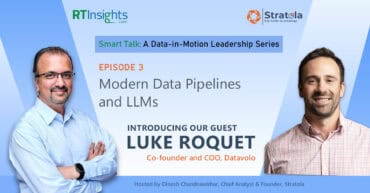
In this week’s real-time analytics news: Several AI educational efforts launch, NVIDIA intros new tools for data scientists, and several offerings that address streaming analytics.
Keeping pace with news and developments in the real-time analytics market can be a daunting task. We want to help by providing a summary of some of the items our staff came across each week. Here are some of the news items from this week:
Penn State launched the Artificial Intelligence Center for Engineered Systems. The newly founded, interdisciplinary research center has been established to further foundational and applied artificial intelligence (AI) in engineered systems. It will bring together expertise from 75 researchers representing 24 academic units across Penn State. The center, funded and supported by the University and housed in the School of Electrical Engineering and Computer Science (EECS), is part of Penn State’s new AI Hub to facilitate internal collaborations, technology transition, and external engagement. Vijaykrishnan Narayanan, A. Robert Noll Chair of Electrical Engineering and Computer Science and Engineering in the School of EECS, will serve as the founding director of the Center for Artificial Intelligence Foundations and Engineered Systems (CAFE). Five associate directors representing the College of Engineering, College of Information Sciences and Technology, Eberly College of Science, and the Applied Research Laboratory (ARL) will help guide the research, industry engagement, defense, education, and outreach activities of the center.
NVIDIA introduced more than 50 new and updated tools and training materials for data scientists, researchers, students, and developers of all kinds. The offerings range from software development kits for conversational AI and ray tracing to hands-on courses from the NVIDIA Deep Learning Institute (DLI). They’re available to all members of the NVIDIA Developer Program, a free-to-join global community of over 2.5 million technology innovators who are revolutionizing industries through accelerated computing. The offerings include dozens of new and updated software development kits for high-performance computing, computer vision, data science, conversational AI, recommender systems, and real-time graphics. Additionally, DLI offers five courses that cover topics such as deep learning, data science, autonomous driving, and conversational AI. All include hands-on exercises that accelerate learning and mastery of the material.
Oracle announced GoldenGate is now available as an elastic, pay-as-you-go cloud service. The new Oracle Cloud Infrastructure (OCI) GoldenGate service provides users with a real-time data fabric platform to design, execute, orchestrate, and monitor their data replication and streaming data events. OCI GoldenGate can be used for general-purpose database replication, data integration, real-time data ingestion to cloud, and support for time-series analytics while data is in flight. The OCI GoldenGate service addresses event-based data integration for operational databases and analytic data stores. With OCI GoldenGate, the exact same technology can be applied to mission-critical operational data stores as well as for real-time data warehouses, data lakes, and streaming analytics. Unifying the operational and analytic data integration fabric helps users to simplify their data architecture, avoid fragmented, complex tooling, and ensures that the data being used for analytics is both timely and trusted. A unified approach aligns the operational systems of record to the business analytics more closely than possible with legacy batch processing tools.
Google Cloud and Siemens announced a new cooperative effort to optimize factory processes and improve productivity on the shop floor. Siemens intends to integrate Google Cloud’s leading data cloud and artificial intelligence/machine learning (AI/ML) technologies with its factory automation solutions to help manufacturers innovate for the future. The companies will combine industrial automation and software from Siemens with Google Cloud’s offerings in real-time analytics and AI/ML. The goal of the cooperation between Google Cloud and Siemens is to make the deployment of AI in connection with the Industrial Edge—and its management at scale— easier, empowering employees as they work on the plant floor, automating mundane tasks, and improving overall quality.
IBM announced new capabilities for IBM Watson designed to help businesses build trustworthy AI. These capabilities further expand Watson tools designed to help businesses govern and explain AI-led decisions, increase insight accuracy, mitigate risks, and meet their privacy and compliance requirements. The capabilities announced include new data privacy management capabilities, enhanced explainability for planning forecasts, new Federated Learning capabilities, and new Time Series capabilities. This news builds on IBM’s commitment to the ethical, responsible stewardship of AI. In addition to applying its Principles of Trust and Transparency across the full scope of global operations, IBM recently joined forces to launch the Global AI Action Alliance focused on guiding the responsible policies, practices, and partnerships needed to ensure global cooperation on the design, development, and use of AI.
Cedalo, the company behind the two Eclipse open-source projects Mosquitto and Streamsheets, has released Streamsheets in the new version 2.3. It focuses on interoperability and integrations. New crypto features enable the secure transfer of sensitive data between applications. Additional cell functions facilitate the work of streamsheet creators, e.g., to convert data from JSON to XML. The release also offers additional wizards to better set up graphs. The new chart type “Map” allows the display of any data on country and regional maps. In Streamsheets, external services can already be controlled via HTTP – request functions. Streamsheets is aimed at professional users who need to monitor, transform, and display continuously incoming data (“streaming data”) in real time in their business and production processes. In this no-code environment, business users can map their processes using spreadsheet logic without having to know how to program.
GigaIO announced FabreX release 2.2, a native PCI Express (PCIe) Gen4 universal dynamic fabric, which supports NVMe-oF, GDR, MPI, and TCP/IP. This new release offers scalability over a PCIe fabric for AI workloads by enabling the creation of composable GigaPods and GigaClusters with cascaded and interlinked switches. In addition, FabreX 2.2 delivers performance improvements of up to 30% across all server-to-server communications through new and improved DMA implementations. GigaIO’s technology enables an entire rack to be treated as the compute unit. All I/O resources normally located inside the server (GPUs, FPGAs, Optane high-performance storage) can now be pooled in accelerator or storage appliances where they are available to all the servers in the rack. Components such as Intel Optane SSDs continue to communicate over native PCIe (and CXL in the future), as they would if they were still plugged into the server motherboard, for the lowest possible latency and highest performance.
Atos and DreamQuark announced the launch of the Sustainable Investment Brain, the first digital platform for banks and insurers that is dedicated to socially responsible investment (SRI) and compliant with the principles of transparent artificial intelligence as set out in recently proposed European regulations. The Sustainable Investment Brain combines DreamQuark’s algorithmic know-how with Atos’ expertise in data management and decarbonization. In other Atos news, Atos announced it has reached an agreement to acquire Ipsotek, a leading AI-enhanced video analytics software provider. With this acquisition, Atos will strengthen its position in Edge and Computer Vision by adding key software capabilities and IP to its solutions portfolio.
Unity announced the availability of Unity Computer Vision Datasets aimed to reduce the cost of developing computer vision applications and more quickly train AI for the manufacturing, retail, and security industries. Computer vision solutions providers can now purchase bespoke datasets for their AI training needs, all while maintaining strict privacy and regulatory standards. Unity’s Computer Vision Datasets make use of a technique known as “domain randomization” to create diverse datasets that improve quality and control bias in applications. The process outputs permutations of how objects of interest are positioned and orientated, including variances in lighting and camera angles as well as the countless configurations to the Unity environment that are possible.
BrainChip Holdings Ltd. introduced MetaTF, a versatile ML framework that allows people working in the convolutional neural network space to quickly and easily move to neuromorphic computing without having to learn anything new. The MetaTF development environment is an easy-to-use, complete machine learning framework for the creation, training, and testing of neural networks, supporting the development of systems for Edge AI on BrainChip’s Akida event domain neural processor. The MetaTF development environment leverages TensorFlow and Keras for industry-standard neural network development and training and includes the Akida Execution Engine (chip simulator), data-to-event converters, and a model zoo of pre-trained models. The framework leverages the Python scripting language and its associated tools and libraries, including Jupyter notebooks and NumPy.
HVR announced HVR Agent as a Service for Microsoft Azure, an Azure Managed Application in the Azure Marketplace. The service enables enterprises to leverage the features and capabilities of HVR to establish a secure, scalable, and high-performing real-time replication environment in Azure – without using internal IT resources. With HVR Agent as a Service, everything is already configured – saving time, money, and resources – so organizations can start replicating quickly. Once data is replicated in real time to Azure, organizations are able to harness the power of that data in the cloud for an optimized business. Key features of HVR Agent as a Service for Microsoft Azure include scalability, availability, monitoring, upgradability, and security.
Canonical released Ubuntu 21.04 with native Microsoft Active Directory integration, Wayland graphics by default, and a Flutter application development SDK. Separately, Canonical and Microsoft announced performance optimization and joint support for Microsoft SQL Server on Ubuntu. Ubuntu machines can join an Active Directory (AD) domain at installation for central configuration. Ubuntu 21.04 adds the ability to configure system settings from an AD domain controller. Using a Group Policy Client, system administrators can specify security policies on all connected clients and desktop environment settings. Additionally, enterprise performance and scalability work from this release have been backported to Ubuntu 20.04.2 LTS, in support of Microsoft SQL Server. Canonical and Microsoft will provide integrated support for Ubuntu with Microsoft SQL Server deployed on-prem or through the Azure Marketplace, for mission-critical workloads.
Amplitude introduced its Digital Optimization System, to manage, measure, and optimize the business value of digital product innovation. The Amplitude Digital Optimization System helps digital teams, including product, marketing, engineering and beyond, deeply understand customer behavior in the digital product, predict which features and actions lead to business outcomes, and adapt each experience in real time to maximize its business impact. Building on its digital product analytics suite, Amplitude also announced the general availability of its new personalization product, Amplitude Recommend. Recommend is a personalization solution that leverages customer behavior data in the digital product and machine learning models to determine which behaviors result in the optimal business outcome, such as conversion to purchase or average order size. The system then adapts each individual experience based on these insights to optimize the desired outcome.
ADTANCE announced its ADTANCE Support and Fieldstreaming solution has been optimized to work with the Starlink beta, the new high-speed, low-latency broadband satellite internet. The combined solution marks the first time multi-camera fieldstreaming video customer support is possible in locations where internet access is not currently available or reliable. With Starlink, ADTANCE enables customer support technicians across the globe to provide multi-camera video assistance to users located in rural and remote areas, including the middle of the ocean, deep in a rainforest or inside an underground building where Wi-Fi and mobile data connections are not possible.
airSlate announced the availability of its no-code, easy-to-configure integration with Microsoft SharePoint. Any individual – whether technical or non-technical – is now able to automate custom workflows directly from their SharePoint accounts. With the new integration, SharePoint users will be able to generate actionable documents pre-filled with SharePoint list data; set conditional routing of documents between CRM contacts, internal, and external recipients; create new records based on data entered into a document’s fillable fields; update existing records based on data entered into a document’s fillable fields; save documents to SharePoint list attachments or external storages; and send batches of documents with a single click.
Wind River is collaborating with Vector to deliver service-oriented architecture (SOA) capabilities for the development of advanced driver assistance systems (ADAS) and automated driving based on the AUTOSAR Adaptive standard to continuously enhance vehicle functionality and value over time. The joint solution comprises Vector’s AUTOSAR Adaptive technologies and the new Wind River Studio, which includes the VxWorks® real-time operating system (RTOS). Wind River Studio is the industry’s first cloud-native platform for the development, deployment, operations, and servicing of mission-critical intelligent systems. The combined solution will support safety-critical applications that require hard real-time, deterministic performance and allow auto manufacturers to deliver SOA components to address a mixed-criticality environment.
JFrog Ltd. announced that the JFrog DevOps Platform Enterprise+ plan is now available on the Google Cloud Marketplace as a SaaS subscription. The JFrog DevOps Platform, a multi-cloud, universal DevOps platform, uniquely drives continuous software releases from source to any deployment target. Google Cloud customers can now quickly and easily deploy the JFrog Platform with full Enterprise+ subscription capabilities in just a few clicks via the Google Cloud Marketplace. The JFrog Platform Enterprise+ subscription is a comprehensive DevOps offering from JFrog designed to enable large enterprises to support the needs of modern application delivery, at scale including binaries management, container registry, built-in security, CI/CD pipelines, and advanced distribution capabilities.
Real-time analytics news in brief:
The European Commission proposed new rules and actions aiming to turn Europe into the global hub for trustworthy Artificial Intelligence (AI). The combination of the first-ever legal framework on AI and a new Coordinated Plan with Member States will guarantee the safety and fundamental rights of people and businesses while strengthening AI uptake, investment, and innovation across the EU. New rules on Machinery will complement this approach by adapting safety rules to increase users’ trust in the new, versatile generation of products.
TigerGraph announced that TigerGraph Cloud is now available on the Google Cloud Platform (GCP). It is already available on Amazon AWS and Microsoft Azure. The company also announced connectors for Snowflake and Tableau, meaning users can access relationship analytics directly from their Snowflake and Tableau dashboards. In addition to extending its product capabilities, TigerGraph is listening to its developer community by rolling out new support and services. TigerGraph’s Developer Community is a global network for developers that fosters a collaborative, supportive, and developer-centric environment.
Xilinx Inc. introduced the Kria portfolio of adaptive system-on-modules (SOMs), production-ready small form factor embedded boards that enable rapid deployment in edge-based applications. Coupled with a complete software stack and pre-built, production-grade accelerated applications, Kria adaptive SOMs are a new method of bringing adaptive computing to AI and software developers.
Loft Labs announced that vcluster, a virtual cluster technology for Kubernetes, is now freely available on GitHub and on www.vcluster.com. With Loft, any Kubernetes cluster becomes a self-service platform where engineers can create namespaces and virtual clusters whenever they need them. At the same time, Loft’s sleep mode and cluster sharing technologies help eliminate idle workloads and save cloud computing costs.
Subex launched HyperSense, an end-to-end Augmented Analytics platform that helps enterprises make faster, better decisions by leveraging Artificial Intelligence (AI) across the data value chain. HyperSense contains all the Augmented Analytics capabilities enterprises need in one flexible and modular platform. HyperSense‘s unique no-code capabilities allow users without a knowledge of coding to easily aggregate data from disparate sources, turn data into insights by building, interpreting, and tuning AI models, and effortlessly share their findings across the organization.
If your company has real-time analytics news, send your announcements to ssalamone@rtinsights.com.
In case you missed it, here are our most recent previous weekly real-time analytics news roundups:





























